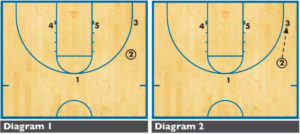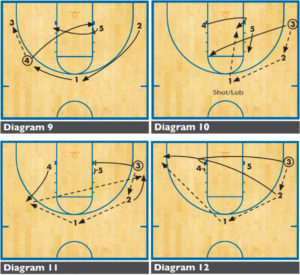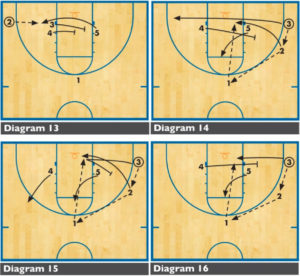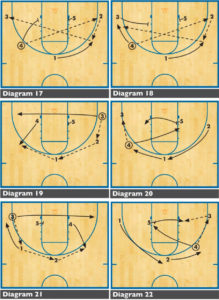A zone offense to break zone defenses
Nearly every year that I coached, we ran some version of this zone offense. There is continuity, but also the option of running some very effective set plays.
 The original version of this offense came from Tom Davis, who coached at Boston College, Stanford, Iowa and Drake. It’s simple, versatile and very effective with proper execution and sound fundamentals. It has both a strong inside and outside game, and it doesn’t matter how you get into the offense. That is up to the coach implementing it.
The original version of this offense came from Tom Davis, who coached at Boston College, Stanford, Iowa and Drake. It’s simple, versatile and very effective with proper execution and sound fundamentals. It has both a strong inside and outside game, and it doesn’t matter how you get into the offense. That is up to the coach implementing it.
 DIAGRAM 1 shows the basic set the offense is run from. You will want to fast break first and then transition into the basic overload set. However, the ball should be passed to 3 on the baseline to flatten out the defense and begin the offense (DIAGRAM 2 — click the diagrams to enlarge). From there, the continuity can begin or a special play can be run.
DIAGRAM 1 shows the basic set the offense is run from. You will want to fast break first and then transition into the basic overload set. However, the ball should be passed to 3 on the baseline to flatten out the defense and begin the offense (DIAGRAM 2 — click the diagrams to enlarge). From there, the continuity can begin or a special play can be run.
The triangle overload should be utilized to its fullest. On the ball reversal continuity begins, and on the pass from 2 to 1, 3 runs the baseline and 4 pops out for the pass and a shot if they are open (DIAGRAM 3). When 4 has the ball at the wing, one of the offense’s best options is available. 5 sets a screen on the back defender in the zone, and 2 drops down to the deep corner. 4 should always check if 2 is open in the corner for a skip pass (DIAGRAM 4).
 After 4 passes to 2, 2 has the option to shoot the 3-pointer or reverse the ball to 1 and restart the continuity. If 2 does shoot the ball, there is great backside rebounding with 3 and 4 in position (DIAGRAM 5).
After 4 passes to 2, 2 has the option to shoot the 3-pointer or reverse the ball to 1 and restart the continuity. If 2 does shoot the ball, there is great backside rebounding with 3 and 4 in position (DIAGRAM 5).
If 4 doesn’t make the pass, he or she looks to pass the ball to 3 in the ball-side corner. That leads to a post rotation of some kind, and there are different ways you can rotate 4 and 5, depending on the coach’s preference. 4 can cut through the high post area headed to the backside block area, and 5 would then cut low across the baseline to the ball-side block (DIAGRAM 6). The guards on the perimeter also rotate to the ball, as 1 rotates to the ball-side wing and 2 rotates to the point.
 There are alternative ways to rotate 4 and 5. In DIAGRAMS 7 AND 8, 4 passes to 3 in the corner and he or she posts up on the ball-side block. 1 and 2 rotate like they normally would in the continuity. On the pass from 3 to 1 at the wing, 5 flashes to the high post and 4 cuts low across the lane to the backside block.
There are alternative ways to rotate 4 and 5. In DIAGRAMS 7 AND 8, 4 passes to 3 in the corner and he or she posts up on the ball-side block. 1 and 2 rotate like they normally would in the continuity. On the pass from 3 to 1 at the wing, 5 flashes to the high post and 4 cuts low across the lane to the backside block.
In DIAGRAM 9, when 4 passes to 3, 4 runs a give-and-go cut to the basket, and 5 cuts through the middle of the lane and cuts to the ball-side block. 1 and 2 rotate on the perimeter as normal.
 There also are some effective special plays you can run from the basic overload set. One where we have had some success is the shot-lob play (DIAGRAM 10). The ball is passed to 3 in the baseline corner, which makes the zone cover 3. The ball is passed back to 2 at the wing and then 1 at the point. In the normal continuity, 4 pops out to the wing and 3 runs baseline. On this play, 3 cuts through in front of 5 to the opposite elbow, and 5 flashes high to the elbow on his or her side. 4 cuts low on the baseline across the lane and 1 can take the shot. 4 also may be open for the catch and layup. This play usually works very well.
There also are some effective special plays you can run from the basic overload set. One where we have had some success is the shot-lob play (DIAGRAM 10). The ball is passed to 3 in the baseline corner, which makes the zone cover 3. The ball is passed back to 2 at the wing and then 1 at the point. In the normal continuity, 4 pops out to the wing and 3 runs baseline. On this play, 3 cuts through in front of 5 to the opposite elbow, and 5 flashes high to the elbow on his or her side. 4 cuts low on the baseline across the lane and 1 can take the shot. 4 also may be open for the catch and layup. This play usually works very well.
DIAGRAM 11 illustrates another play. The ball is passed to 3 and back to 2 at the wing. 2 passes to 1 at the point and 4 pops out to the wing. 1 passes to 4 and 4 skip passes to 2, who dropped to the corner behind the 3-point line. As 3 runs the baseline as normal, they stop and set a double screen with 5 on the backside of the zone to get 2 open for the 3-pointer.
 DIAGRAMS 12-13 show a third option. After the pass, 3 reverses the ball to 2 as 3 cuts baseline. 3 stops just outside the other side of the lane and sets a double screen with 4, who did not pop out to the wing. When 2 passes to 1 at the point, they quickly cut through below the double screen to the other corner. 1 waits for 2 to get to the corner and then passes the ball to 2 for the shot. This action usually makes the baseline zone defender rush to cover 2.
DIAGRAMS 12-13 show a third option. After the pass, 3 reverses the ball to 2 as 3 cuts baseline. 3 stops just outside the other side of the lane and sets a double screen with 4, who did not pop out to the wing. When 2 passes to 1 at the point, they quickly cut through below the double screen to the other corner. 1 waits for 2 to get to the corner and then passes the ball to 2 for the shot. This action usually makes the baseline zone defender rush to cover 2.
When the baseline defender fights through or over the double screen set by 3 and 4, that keys 3 and 4 to screen defenders in and across the lane. This opens up 5 to cut across the lane on the baseline for a pass from 2 for an easy shot or layup.
A fourth play from the original overload set is shown in DIAGRAM 14. With the ball in the corner, 3 reverses the pass to 2 at the wing and 2 passes to 1 at the point as 3 runs the baseline. 4 does not pop out and cuts low across the lane, as 5 flashes to the middle high post. 4 continues to cut across the lane to set a screen on the zone defender closest to 2. When 2 receives that screen, they cut to the basket for a lob pass and layup.
 Another way to run the same play is shown in DIAGRAM 15. 3 passes to 2 at the wing and 2 passes to 1. 4 pops out to the wing, and 5 flashes to the middle high post. 3 stops at the basket and doubles back to set the screen for 2, who cuts to the basket for a lob pass from 1.
Another way to run the same play is shown in DIAGRAM 15. 3 passes to 2 at the wing and 2 passes to 1. 4 pops out to the wing, and 5 flashes to the middle high post. 3 stops at the basket and doubles back to set the screen for 2, who cuts to the basket for a lob pass from 1.
DIAGRAM 16 is from the same overload set. 3 passes to 2 at the wing and 2 finds 1 at the point. 5 flashes to the middle high post and 4 cuts across the lane and sets a screen for 3, who cuts to the basket for a lob and layup.
From the normal continuity, you can run this option anytime the ball is skipped to 2 behind 5’s screen. 1 rotates to the ball-side wing and 2 passes to 1, who then passes to 3 for a 3-pointer behind 4’s screen. If 4 is a better 3-point shooter, then have 3 set the baseline screen while 4 drops to the corner for the shot attempt (DIAGRAMS 17-18).
DIAGRAMS 19-22 illustrate the continuity zone offense the way we ran it. This offense works against every zone defense. It has many great options and set plays, and it’s worked for us over many years. Give it a try, and I think you’ll find it effective.









